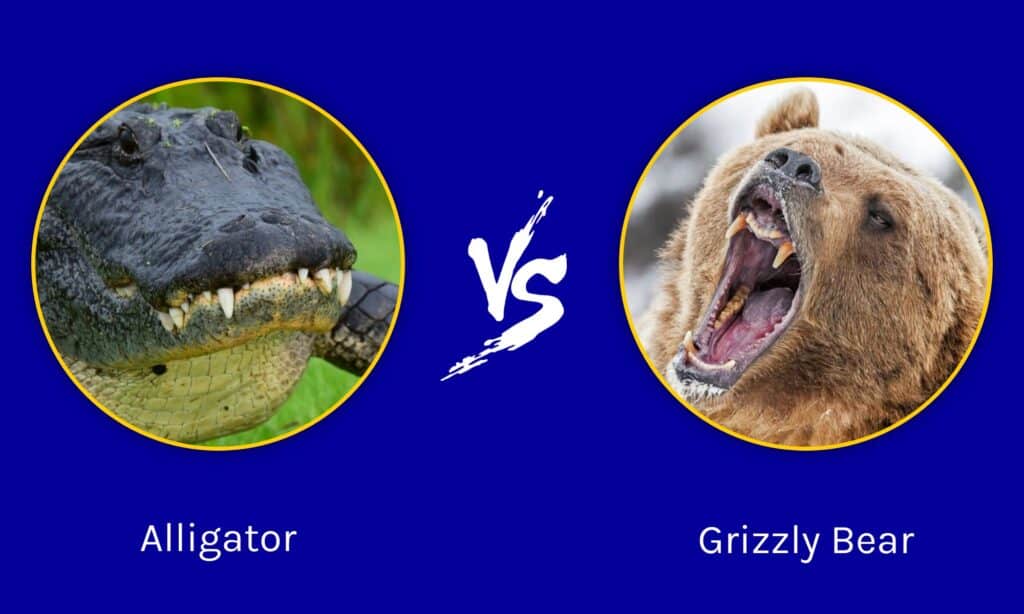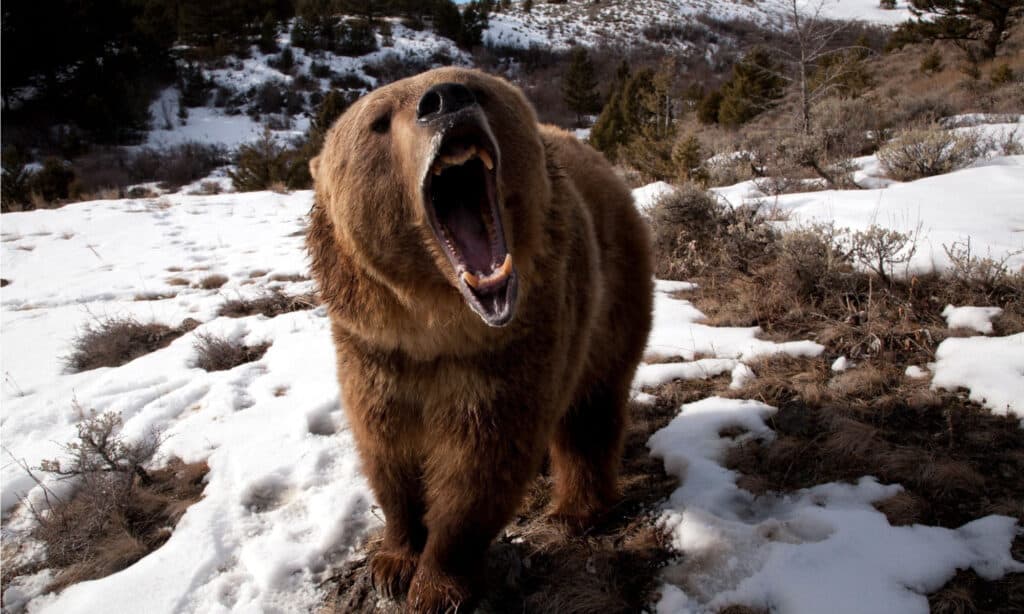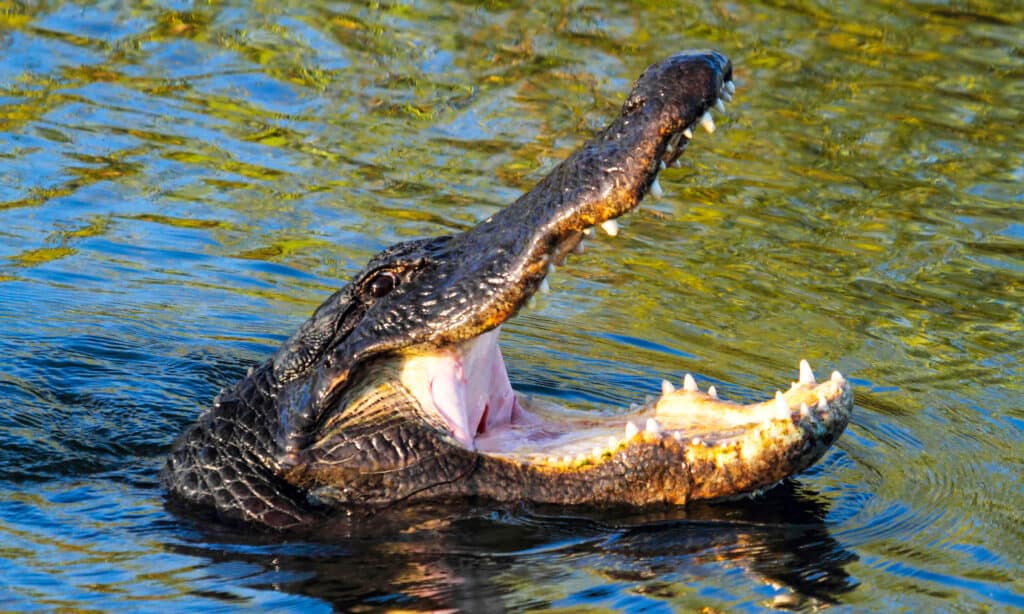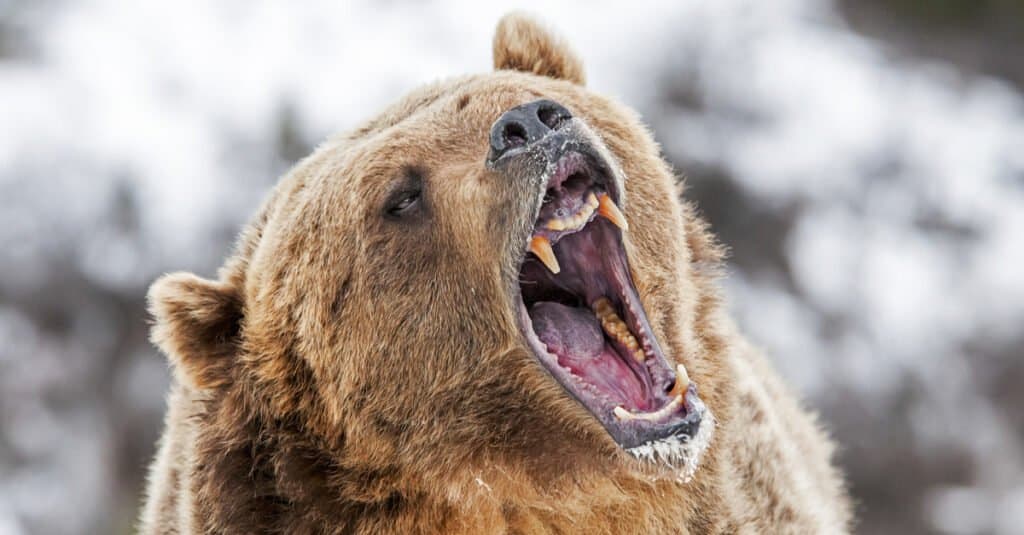We’ve previously mentioned how a saltwater crocodile would take out a bear if it came to a fight. Yet, we have to wonder what would happen if we evened the odds out a bit by having the alligator face off against one. Today, we’re going to look at an alligator vs grizzly bear fight and show you which animal is going to win the battle and why it would work this way.
Just for the sake of fairness, we’re going to use the American alligator rather than the Chinese alligator to provide a more formidable matchup. Without further ado, let’s get down to the tale of the tape!
Comparing an Alligator and a Grizzly Bear

| Alligator | Grizzly Bear | |
|---|---|---|
| Size | Weight: 400lbs to 800lbs (sometimes more) Height: 1ft – 2ft off the ground Length: 8.2 feet to 15 feet long | Weight: 400lbs-700lbs Length: 7ft-10ft Height: 3ft-4ft at the shoulder |
| Speed and Movement Type | – 30 mph over short distances on land – Up to 20 mph in the water – Locomotion includes swimming and scampering on the ground | – 35 mph on land – Roughly 6 mph in the water |
| Defenses | – Camouflage – Thick skin – Limited snake venom resistance – Speed – Hissing threat display | – Thick skin – Large size – Stands on hind paws for threat display |
| Offensive Capabilities | – 2,980 PSI bite power – Roughly 80 teeth – Teeth roughly 2” in length – Death roll can instantly amputate – Repeated chomping can puncture organs while holding prey in place | – 975 PSI bite – 42 teeth that measure about 1 inch in length – Strong bites, vicious shaking attacks – 4-inch claws – Powerful swipe attacks |
| Predatory Behavior | – Ambush prey by keeping eyes and nostrils above water – Typically attacks by ambushing from the water – Clamp onto enemies and use a death roll | – Opportunistic predators – Scavengers |
What Are the Key Differences Between an Alligator and a Grizzly Bear?

Grizzly bears are known for their large shoulder hump and aggressive demeanor.
©Falade Adewale/Shutterstock.com
The biggest differences between an alligator and a grizzly bear are found in their morphology. Grizzly bears are large ursine mammals covered in brown, sometimes white-tipped fur that is mostly quadrupedal but can stand on two feet when attacking. Alligators are large reptiles with U-shaped snouts, large mouths, scaly and bumpy skin, and long tails.
Identifying these differences is a great starting ground for discovering the factors that will ultimately decide if the alligator or grizzly bear wins the right. Yet, we need more information to make that decision.
What Are the Key Factors in a Fight Between an Alligator and a Grizzly Bear?

The largest American alligator on record was 19 feet, two inches.
©iStock.com/Bradley Proxmire
Battles in the wild are determined by a handful of factors rather than vast amounts of data. Knowing how a creature attacks, how fast it is, and how it initializes its assaults are very helpful bits of information. In this case, we’ll consider five components in the battle and then see which animal has the advantage in that area. By the time we’re finished, we’ll have a very good idea of which creature will win this battle.
Alligator vs Grizzly Bear: Size
The average alligator is quite large, weighing between 400 and 800 lbs, standing 1-2ft off the ground, and growing anywhere from 8-12ft long with its long tail. However, the largest alligators that have ever been caught weighed over 1,000 lbs!
Grizzly bears are very large mammals that can weigh up to 700 lbs, grow to be 10ft long, and will often stand 4ft high at the shoulder. Some of the larger bear populations can weigh upwards of 900 lbs, and the largest grizzly bears weighed nearly 1,200 lbs!
Grizzly bears are larger than alligators on average.
Alligator vs Grizzly Bear: Speed and Movement
Alligators can typically move somewhere between 2 and 9 mph when they are on land, but they can dash over extremely short distances at a speed of 30 mph. We cannot emphasize enough how small of a distance that would be, though.
Grizzly bears can swim at a speed of about 6 mph, but they can run at 35 mph on land, and they can hold that speed for a much longer distance than an alligator. They have been seen chasing down moose, deer, and other prey with relative ease.
Grizzly bears are faster on land, but alligators are faster in the water.
Alligator vs Grizzly Bear: Defenses
Grizzly bears are large animals with thick skin and a scary threat display that sees them standing, huffing, and clacking their teeth at creatures they don’t like, such as humans. Most animals know not to mess with something this massive, so they opt for bear cubs.
Alligators have substantial defenses in terms of their large size, thick scaly skin, and ability to hide in water and vegetation.
Alligators have a defensive advantage, but it may not prove successful against very powerful creatures.

Alligators have a massive biting power at nearly 3,000 PSI and 2-inch teeth.
©Steve Byland/Shutterstock.com
Alligator vs Grizzly Bear: Offensive Capabilities
Grizzly bears bring with them several methods of attack. They can use devastating paw swipes to knock prey and slash it with 4-inch claws. They also have a 975 PSI bite with their 1-inch canines to puncture their prey’s skull, grab it, and viciously shake it. Grizzlies are also smart enough to maneuver prey to give themselves access to the prey’s weak spots.
Alligators only do one thing well and that’s biting. They have massive biting power at nearly 3,000 PSI, 2-inch teeth, and the instinct to perform a death roll to amputate limbs from prey.
Grizzly bears have the offensive advantage with more diverse attacks and higher intelligence.
Alligator vs Grizzly Bear: Predatory Behavior
Grizzly bears are known as opportunistic predators that follow their great senses to food. Once they find it, they attack and eat it. They are also scavengers. In this case, their predatory behavior doesn’t help them much. Still, they are intelligent creatures, and their smarts can keep them safe.
Alligators attack prey by leaving their eyes and nostrils above the waterline, waiting for prey to come to their hiding spot. Once something gets close enough, they’ll ambush their prey, dashing from the water to grab them and try dragging them into the water. They can take down fairly large prey using this method.
Who Would Win in a Fight Between an Alligator and a Grizzly Bear?

Grizzly bears have the tenacity and raw power to take down an alligator.
©Scott E Read/Shutterstock.com
A grizzly bear would win a fight against an alligator. Although the alligator has a very powerful bite, it cannot match the grizzly bear for sheer power. The best-case scenario for the alligator is that it ambushes the grizzly bear on land. Even in that case, the alligator might bite a leg, but it would catch a swift, smashing paw to the head that has enough power to knock it unconscious.
The grizzly bear would then continue beating and clawing the alligator, eventually flipping it on its sides and back to maul it with its powerful bite. That’s the best-case scenario for the alligator!
The worst-case scenario for the alligator is that the grizzly bear spots it on land and tears after it. Before the reptile can make it to the water, the grizzly mails it to death with a combination of bites to the skull and powerful swipes.
Could Another Animal Take on a Grizzly?
Grizzly bears are formidable beasts capable of mauling just about anything to death – even a giant gator! Alligators only have their powerful jaws and bite force going for them on land – maybe another apex predator used to preying on larger land animals could take the grizzly down. How would a grizzly do against the king of the jungle – the mighty lion?
Lions are smaller than grizzlies at 550 lbs to the bear’s 700, but is size the deciding factor in this battle? Lions are patient predators who silently stalk their victims and wait on the perfect opportunity to ambush. They grab prey with powerful front legs and dig their long claws in to hold on. One crushing bite to the neck usually finishes the animal off before it is dragged off to be dinner for the pride. Bears, as we’ve learned, just see an opportunity and go for it full force by overpowering and mauling their victims.
In the bite force category – the animals are competitive. Grizzly bears can bite with a force of 975 PSI, while lions can bite somewhere between 650 – 1,000 PSI. What about their claws? Grizzlies have four-inch-long claws on massive powerful paws that deliver deadly swipes. Lions mostly use their claws to dig into their prey to give them a chance to deliver that famous killing bite.
In a one-on-one fight between an extra-large lion and the average grizzly – the bear would most certainly win. The more nuanced fighting style of the lion would be no match for a grizzly, standing on its hind legs, swiping the lion over and over with massive paws and razor-sharp claws, biting and mauling, and just wearing the cat down. The bear would leave the battle scared and bloody – but the big cat would go from predator to prey in a matter of minutes.
The photo featured at the top of this post is © Mia2you/Shutterstock.com
Thank you for reading! Have some feedback for us? Contact the AZ Animals editorial team.






